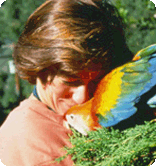Adding a new parrot to the flock

We have two parrots in our living room: a female Congo African Grey born on 24.11.09 and a female Meyers parrot born on 24.03.10. As they do not like each other, they live in separate cages. For quite a while now I am considering to get a companion for our African Grey. The two of them should live in the same cage. Please give me your opinion/advice about that.

Hello Heidy, thank you for your support of World Parrot Trust and for asking about this important issue that affects captive parrots.
First, it’s generally not a good idea to get a parrot as a companion for another parrot. You got your Congo Grey in order to be a companion to you, so if either of you is unhappy or unfulfilled in that relationship, you need to start there, with the relationship between you and your Grey. Make an honest assessment of what you can do to make your Grey’s life as your companion more satisfactory, then do it. If you feel like you don't have time for her, or if you feel like she’s bored or lonely, then you need to alleviate those issues or any others that underlie your concerns.
It’s imperative to work on the dynamic between the two of you. Strengthen and broaden your relationship with her by providing her with parrot-centric enrichments and increasing the amount of quality time you spend together. Observe what she likes to do and give her lots and lots of opportunities to do that and to grow as an individual. Do the same for your Meyer’s.
Another reason not to get a companion parrot for a companion parrot is that we humans aren't infallible choosers. Most often, the parrot a human chooses to be another parrot’s “friend” is not one your Grey would choose. It’s like having someone chose your best friend or spouse – it doesn't work. Too random. Too many variables.
Even if, by sheer improbable luck, you got a parrot your Congo liked, the chances of them being compatible enough to share a single cage is slim to none. Maybe for a little while, and only then if the cage is huge, but not for long. Imagine being locked in the same room with another person – even a person you are wildly crazy in love with -- for hours each day and every night, week in and week out, month after month, never knowing for sure how long you'll be subjected to that confinement. Now imagine that same situation with someone you don't like that much. Or someone you like at first, but after a while they get on your nerves. Or someone you like just fine except for one annoying thing they do over and over and over.
Both of your parrots are young – they still have a lot of growing up to do. As they grow, you'll see them change, which is a large part of the joy of keeping companion parrots. Slowly, over time and with the right provisions, they might even end up liking each other. It will be great fun for you to give them everything you possibly can that helps them build a healthy friendship. Two play gyms placed far enough apart so they can each have their own space, separate, but in view of each other. Shared snack times, shared interactions with you; both of them in the kitchen while you make their breakfast, one on the windowsill, the other on a perch; both out of their cages in the same room, comfortable, preening, chortling, goofing off in that easy companionable way that characterizes friends. Make that happen before you decide that you need or want another parrot for yourself.
We must remember, always, that companion parrots are wild animals. If we could regress each one back into their eggs, and those eggs could be placed in a nest in the wild, they'd hatch and be successful as wild birds. The same cannot be said for puppies or kittens. As wild animals who share our homes, parrots need a super-abundance of concessions made for their happiness and well-being.
Simply put, companion parrots like, need and deserve space and room. Enough so they get to decide for themselves how they want to spend their time, not just a cage to sit in while they wait for a human to give their lives meaning or entertainment. When they get to decide, it’s pleasantly surprising how often they decide to hang out with us.
It’s our responsibility as caregivers to provide big open spaces where they can flap, swing, climb and move about freely. Companion parrots need environments large enough to include a variety of fresh branches thoughtfully arranged and frequently changed, a secure and private sleeping area, feeding stations, foraging places, things to chew, and plenty of access to us, their friends. Their environments should be complex enough so that they get to make choices about what they want to do and when they want to do it. Once those provisions are in place, you can see if your Meyer’s and Grey get along better. Chances are, they'll like each other more when their space is more like a parrot playground than a shared cage.
One of the major lessons my husband and I have learned over the 30+ years we've kept parrots is the larger we make our indoor bird rooms and outdoor aviaries, the happier our parrots. And us. Our happiness depends on them having the spaces they need and deserve. When they get to fly and zoom around a big space designed for them, when they get to choose which bowl they'll eat from, what days they shower or bathe, what they forage with, who they share a perch with, when they need privacy and where they get it – that’s when “captivity” turns into “compatibility.”
With all best wishes,
Phoebe Greene Linden and flock

































